





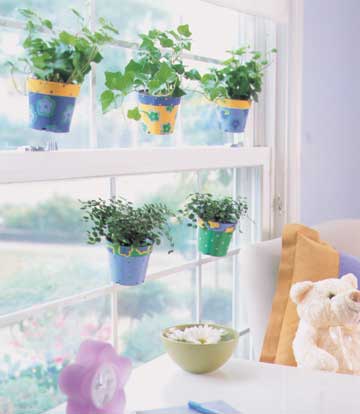
Winter is an ideal time to give your houseplants a thorough inspection, checking for pests, diseases, and any other problems that prevent them from looking their best. Lackluster leaves and a scarcity of blooms could be a sign that the growing conditions are not optimum.
Don't underestimate the value of the right amount of light for plants. Although a plant may not show the effect of too little light right away, in time it will deteriorate.
Plants are often classified as needing low, medium, or high light. As a guide, figure low light to be that from a north window, medium from an east or west window, and high from a south window. Another way to judge exposure is by the shadow cast by the plant. If it is barely discernible, the light is low; when the shadow is present but indistinct, the light is medium; when the shadow is sharp, the light is bright. Choose plant types according to the light conditions you can give them.
It is also possible to give too much light to a plant, resulting in compacted growth and burned foliage. If this happens, move the plant farther from the window or put a sheer curtain on the window.
Windowsill plants tend to lean toward the source of light. To keep houseplants shapely, give their pots a quarter turn every time you water.
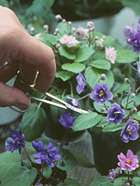
Most plants, with the exception of cacti and succulents, like high humidity. Misting is a way to raise humidity, but you'll need to do it several times a day to be effective.
Another way to raise humidity around plants is to group them together on a tray of wet gravel. Put enough gravel in the tray so the pots will not sit directly in water.
Learn more about houseplants and humidity.

Periodic grooming keeps houseplants, such as these miniature African violets, looking good. As flowers fade, clip them off to direct the plant's energy toward growth and flower production, not toward the production of seeds. Pinch the growing tips of foliage houseplants to encourage dense, bushy growth. For a shapely plant, prune off any wayward or misshapen stems.
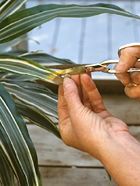
Often, heat or dry conditions can cause plant foliage tips to turn brown and dry out. If this occurs, use scissors to cut off the browned tips at an angle.
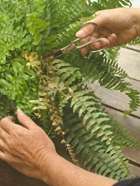
Fronds of Boston ferns can turn brown. Use scissors to clip off brown fronds at the base. Yellow or brown foliage on other plants also should be removed.
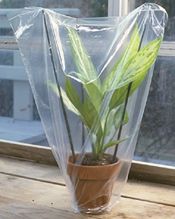
Houseplant pests can spread and multiply rapidly. Act quickly to minimize damage at the first sign of insects. Isolate affected plants and begin control measures. If a pesticide is called for, be sure to use one that is labeled for indoor use, such as an insecticidal soap spray or a houseplant spray containing pyrethrum.
If your plant has a pest problem, you will want to contain the pesticide, for both effectiveness and safety. Plastic around the plant will accomplish both. Remove the plastic after several days.
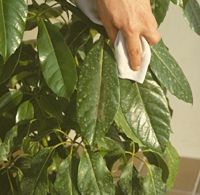
Large, smooth-leaved plants are frequently collectors of dust. In normal housekeeping chores, wash or wipe away dust to keep the plant attractive and to keep it photosynthesizing at its best.
Hairy-leaved plants such as African violets also collect dust. Because moistening the leaves can cause unsightly spots, remove dust with a small paintbrush or by blowing it away.
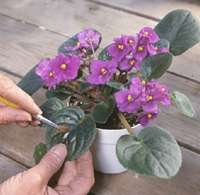
Hairy-leaved plants such as African violets also collect dust. Because moistening the leaves can cause unsightly spots, remove dust with a small paintbrush or by blowing it away.
Here is a list of the most common houseplant ailments along with their descriptions and our suggestions to controlling the problem.
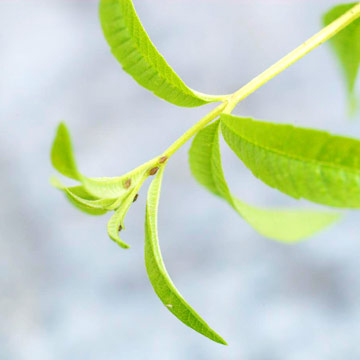
Description and Trouble Signs: Also called common plant lice, these insects are up to 1/8 inch long and can be green, red, black, or brown. They occur mostly on new growing tips and undersides of leaves. By sucking the plant juices, they cause the foliage to yellow and die. They also secrete a honeydew that leaves surfaces below the plant sticky.
Controls: If infestation is not too bad, wash insects away in a strong stream of water. Severe infestations may require treatment with a houseplant insecticide.
Learn how to control aphids.
Description and Trouble Signs: Leaf edges turn crispy and brown, almost as if burned. New growth also quickly becomes brown and loses strength. This can be caused by too high heat, too low humidity, plants becoming too dry between waterings, drafts, or too much fertilizing.
Controls: Determine the problem and correct it. Lower the temperature, raise the humidity, water more evenly, and carefully follow fertilizer directions.
Description and Trouble Signs: Sometimes flower buds will form but will drop off before flowering. The causes of this can be high temperatures, low humidity, drafts, uneven or insufficient watering, too much fertilizer, or shock from being moved while in the bud stage.
Controls: Determine the problem and correct it. Avoid high temperatures, drafts, or too dry soil; keep humidity up.
Description and Trouble Signs: In this case, plants that should produce blooms do not. The reasons for this can be insufficient light or too much nitrogen fertilizer. Also, some blooming houseplants are dependent on day length and must either be shaded or receive supplemental light to produce flowers.
Controls: Give bright light, lower fertilizer amounts, keep humidity high, and keep soil moisture even. Check to see if plants are sensitive to day length.
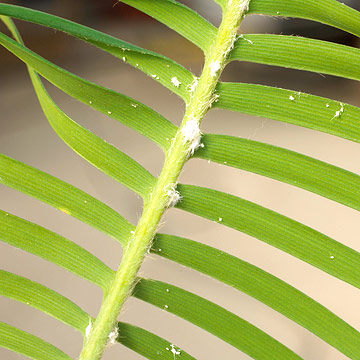
Description and Trouble Signs: Mealybugs have soft, 1/4-inch-long bodies and a coating of white, powdery wax. They look like cotton balls clustered under leaves, in stem crotches, and on top of shaded leaves. They suck out plant juices and can kill plants.
Controls: Control by wetting each insect with rubbing alcohol, applied with a cotton swab. For severe infestations, use repeated applications of a houseplant insecticide.
Learn more about how to get rid of mealybugs.
Description and Trouble Signs: Scales are oval or round, 1/8-inch-long insects with a shell-like covering. Colors are generally brown, black, gray, or white. Scales deposit a sticky, shiny honeydew on leaves. They suck plant juices and can cause plant death.
Controls: Small numbers of scales can be easily removed with soapsuds. Where large numbers are present, use repeated applications of a houseplant insecticide.
Description and Trouble Signs: Spider mites are so tiny they can barely be seen. You will notice yellow flecks or speckling on the upper side of the leaves, an overall dull look to the foliage, and fine webbing (where colonies are large).
Controls: Keep plants properly watered and keep humidity high. A weekly shower in plain, lukewarm water is usually sufficient to keep spider mites under control. For severe infestations, use a houseplant pesticide.
Learn more about getting rid of spider mites.
Description and Trouble Signs: These white insects fly off the plants when disturbed and look like flying dandruff. They suck plant juices, turning foliage yellow. If untreated, whiteflies will eventually kill the plant.
Controls: Several applications of a houseplant insecticide are necessary to control whiteflies. Wash your hands after handling infested plants to prevent spread.
Description and Trouble Signs: Wilt can lead to a quick plant death. It can be caused by too little water or a related condition, such as poor soil, high temperature, or low humidity. Wilt can also be caused by the opposite conditions, including too much water or a waterlogged or poorly drained soil.
Controls: Provide a lower temperature, water more often, raise the humidity, or check the root ball to see if the plant needs repotting.
Description and Trouble Signs: Foliage that turns yellow and falls off indicates many different things: too much or too little light; high temperature; overwatering or poor drainage; too much or too little fertilizer; or polluted air. A certain amount of yellowing foliage and leaf drop is normal and should be expected.
Controls: Check growing conditions to see if any could be causing the problem. Make sure the plant is not too hot, wet, or dry; has the right amount of light; and has enough fresh air.
Get more tips to preventing houseplant problems.
Insect or Disease
Description and Trouble Signs Controls Aphids Also called common plant lice, these insects are up to 1/8 inch long and can be green, red, black, or brown. They occur mostly on new growing tips and undersides of leaves. By sucking the plant juices, they cause the foliage to yellow and die. They also secrete a "honeydew" that leaves surfaces below the plant sticky. If infestation is not too bad, wash insects away in a strong stream of water. Severe infestations may require treatment with a houseplant insecticide. Brown leaf tips Leaf edges turn crispy and brown, almost as if burned. New growth also quickly becomes brown and loses strength. This can be caused by too high heat, too low humidity, plants becoming too dry between waterings, drafts, or too much fertilizing. Determine the problem and correct it. Lower the temperature, raise the humidity, water more evenly, and carefully follow fertilizer directions. Bud drop Sometimes flower buds will form but will drop off before flowering. The causes of this can be high temperatures, low humidity, drafts, uneven or insufficient watering, too much fertilizer, or shock from being moved while in the bud stage. Determine the problem and correct it. Avoid high temperatures, drafts, or too dry soil; keep humidity up. Failure of plant to bloom In this case, plants that should produce blooms do not. The reasons for this can be insufficient light or too much nitrogen fertilizer. Also, some blooming houseplants are dependent on day length and must either be shaded or receive supplemental light to produce flowers. Give bright light, lower fertilizer amounts, keep humidity high, and keep soil moisture even. Check to see if plants are sensitive to day length. Mealybugs Mealybugs have soft, 1/4-inch-long bodies and a coating of white, powdery wax. They look like cotton balls clustered under leaves, in stem crotches, and on top of shaded leaves. They suck out plant juices and can kill plants. Control by wetting each insect with rubbing alcohol, applied with a cotton swab. For severe infestations, use repeated applications of a houseplant insecticide. Scales Scales are oval or round, 1/8-inch-long insects with a shell-like covering. Colors are generally brown, black, gray, or white. Scales deposit a sticky, shiny honeydew on leaves. They suck plant juices and can cause plant death. Small numbers of scales can be easily removed with soapsuds. Where large numbers are present, use repeated applications of a houseplant insecticide. Spider mites Spider mites are so tiny they can barely be seen. You will notice yellow flecks or speckling on the upper side of the leaves, an overall dull look to the foliage, and fine webbing (where colonies are large). Keep plants properly watered and keep humidity high. A weekly shower in plain, lukewarm water is usually sufficient to keep spider mites under control. For severe infestations, use a houseplant pesticide. Whiteflies These white insects fly off the plants when disturbed and look like flying dandruff. They suck plant juices, turning foliage yellow. If untreated, whiteflies will eventually kill the plant. Several applications of a houseplant insecticide are necessary to control whiteflies. Wash your hands after handling infested plants to prevent spread. Wilt Wilt can lead to a quick plant death. It can be caused by too little water or a related condition, such as poor soil, high temperature, or low humidity. Wilt can also be caused by the opposite conditions, including too much water or a waterlogged or poorly drained soil. Provide a lower temperature, water more often, raise the humidity, or check the root ball to see if the plant needs repotting. Yellowing foliage Foliage that turns yellow and falls off indicates many different things: too much or too little light; high temperature; overwatering or poor drainage; too much or too little fertilizer; or polluted air. A certain amount of yellowing foliage and leaf drop is normal and should be expected. Check growing conditions to see if any could be causing the problem. Make sure the plant is not too hot, wet, or dry; has the right amount of light; and has enough fresh air.Copyright © www.100flowers.win Botanic Garden All Rights Reserved